
Cisco 2500 Router products
We sell Cisco
equipment - If you need a part not listed here,
please call us have access to hundreds of dealers around the globe.
jump to 2500 part number page
Documentation
The Cisco 2500 series routers provide a variety of models designed for branch office and remote site environments. These routers are typically fixed configuration with at least two of the following interfaces:
Ethernet (AUI)
10BaseT Ethernet hub
Token Ring
Synchronous serial
Asynchronous serial
ISDN BRI
Cisco 2500 routers come with Flash EPROM technology for simplified software maintenance. These systems support a variety of Cisco IOS software feature sets, so you can choose a feature set that supports your specific protocol environment. The software feature sets range from an IP and bridging-only to the full array of Cisco`s software functionality, including APPN and RMON.
Mission-specific models contain less memory and less hardware functionality to support a subset of protocols. Each mission-specific model can be upgraded to full router capability by downloading a new Cisco IOS software feature set and, if necessary, adding memory.
Cisco 2500 series models can be divided into the following categories:
Single LAN routers — Models 2501, 2502, 2503, 2504, 2520, 2521, 2522 and 2523
Mission-specific, entry-level routers — Models 2501CF, 2501LF, 2502CF, 2502LF, 2503I, 2504I, 2520CF, 2520LF, 2521CF, 2521LF, 2522CF, 2522LF, 2523CF and 2523LF
Router/hub combinations — Models 2505, 2507 and 2516
Access servers — Models 2509 to 2512 (refer to the "Cisco 2500 Series Access Servers" section in the "Access Servers" chapter in the catalog)
Dual LAN routers — Models 2513, 2514 and 2515
Modular routers — Models 2524 and 2525 (optional integrated DSU/CSU or NT-1)
All the Cisco 2500 series models support the features listed in the following table.
|
Description |
Specification |
|---|---|
|
Flash memory |
Minimum of 8 MB of Flash memory, except for the mission-specific routers which require only 4 MB of Flash memory. However, depending on the Cisco IOS release that shipped with the system, it might require more memory. Refer to the "Cisco IOS Software" chapter for the minimum Flash memory required for each feature set. |
|
DRAM memory expandability |
Minimum DRAM required by the Cisco IOS release that shipped with the system. Refer to the "Cisco IOS Software" chapter for the minimum DRAM required for each feature set. |
|
Processor type |
20 MHz 68030 |
|
Software options — Cisco IOS Release 11.2 |
IP Routing |
|
Software options — Cisco IOS Release 11.1 and 11.0 |
IP Routing |
|
Standard components |
Power supply and cord |
If your system requires more than 8 MB of Flash memory, the additional memory must be ordered separately.
This feature set is available with Cisco IOS Release 11.0 and later releases.
The console cable kit includes an RJ-45-to-RJ-45 roll-over console cable, an RJ-45-to-DB-25 male DCE adapter, an RJ-45-to-DB-25 female DTE adapter, and an RJ-45-to-DB-9 female DTE adapter
|
Description |
Specification |
|---|---|
|
Consumption |
For models 2501 to 2525: 40W |
|
Input |
For models 2501 to 2516 and 2520 to 2525: 110 to 220 VAC, 50 to 60 Hz -48 VDC |
|
Current rating |
For models 2501 to 2516 and 2520 to 2525: 1.0A at 60 Hz, 0.5A at 50 Hz |
|
Operating temperature range |
For models 2501 to 2516 and 2520 to 2525: 32 to 104°F (0 to 40°C) |
|
Storage temperature range |
For models 2501 to 2516 and 2520 to 2525: -40 to 185°F (-40to 85°C) |
|
Humidity (noncondensing) |
For models 2501 to 2525: 5 to 95% |
|
Dimensions (H x W x D) |
Models 2501 to 2516 and 2520 to 2525: 1.75 x 17.5 x 10.56 in. (4.44 x 44.45 x 26.82 cm) |
|
Weight (average shipping) |
Models 2501 to 2516 and 2520 to 2525: 10 lb. (4.5 kg) |
The Cisco 2500 series routers are discussed in the following sections:
Memory Options
Single LAN Routers
Mission-Specific Routers
Router/Hub Combinations
Access Servers
Dual LAN Routers
Modular Routers
Hardware Product Numbers
All Cisco 2500 models include a minimum of 8 MB of Flash memory, except for the mission-specific routers which include 4 MB or 8 MB of Flash memory, depending upon the Cisco IOS software release you order. Additional Flash memory can be purchased to allow for dual banking or potential future code growth.
There are two types of DRAM memory in the Cisco 2500 series routers: primary and shared (packet). Primary memory is used to store the operating configuration, routing tables, caches, and queues. Shared memory is used to store incoming and outgoing packets. In the table below, the physical configuration column lists the amount of DRAM SIMM memory supported. The system usage column lists how the system allocates the total DRAM memory installed.
|
|
Physical Configuration |
System Usage |
|
|---|---|---|---|
|
Total DRAM Memory |
DRAM SIMM |
Shared DRAM Memory |
Primary DRAM Memory |
|
4 MB |
4 MB |
2 MB |
2 MB |
|
8 MB |
8 MB |
2 MB |
6 MB |
|
16 MB |
16 MB |
2 MB |
14 MB |
Each Cisco 2501, 2502, 2503, 2504, 2520, 2521, 2522, and 2523 machine contain the common Cisco 2500 series features listed in the following table.
|
Model |
Ethernet |
Token Ring |
Low-Speed Serial1 |
Serial2 |
ISDN BRI |
|---|---|---|---|---|---|
|
Cisco 2501 |
1 |
0 |
0 |
2 |
0 |
|
Cisco 2502 |
0 |
1 |
0 |
2 |
0 |
|
Cisco 2503 |
1 |
0 |
0 |
2 |
1 |
|
Cisco 2504 |
0 |
1 |
0 |
2 |
1 |
|
Cisco 2520 |
1 |
0 |
2 |
2 |
1 |
|
Cisco 2521 |
0 |
1 |
2 |
2 |
1 |
|
Cisco 2522 |
1 |
0 |
8 |
2 |
1 |
|
Cisco 2523 |
0 |
1 |
8 |
2 |
1 |
1. Synchronous and asynchronous.
2. Synchronous.
Figure 18-13: Cisco 2501 Rear View

Figure 18-14: Cisco 2502 Rear View

Figure 18-15: Cisco 2503 Rear View

Figure 18-16: Cisco 2504 Rear View

Figure 18-17: Cisco 2520 Rear View

Figure 18-18: Cisco 2521 Rear View

Figure 18-19: Cisco 2522 Rear View
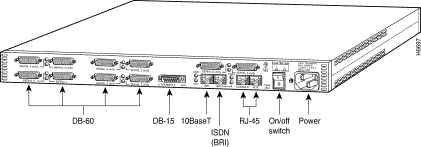
Figure 18-20: Cisco 2523 Rear View
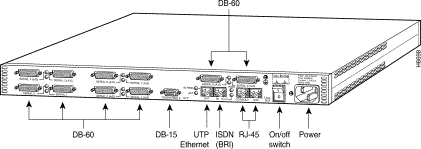
Mission-specific routers are entry-level routers that are based on standard Cisco 2500 hardware. However, mission-specific routers contain less memory than standard models and run reduced software images designed for CFRAD, LAN FRAD, and ISDN applications. These reduced software images disable unused ports. Mission-specific routers can be upgraded to full standard-model functionality by purchasing additional software and memory.
|
Model |
Ethernet |
Token Ring |
Serial |
Low-Speed Serial |
ISDN BRI |
|---|---|---|---|---|---|
|
Cisco 2501CF |
Software disabled |
0 |
2 |
0 |
0 |
|
Cisco 2501LF |
1 |
0 |
2 |
0 |
0 |
|
Cisco 2502CF |
0 |
Software disabled |
2 |
0 |
0 |
|
Cisco 2502LF |
0 |
1 |
2 |
0 |
0 |
|
Cisco 2503I |
1 |
0 |
Software disabled |
0 |
1 |
|
Cisco 2504I |
2516:hardware:interfaces>0 |
1 |
Software disabled |
0 |
1 |
|
Cisco 2520CF |
Software disabled |
0 |
2 |
2 |
Software disabled |
|
Cisco 2520LF |
1 |
0 |
2 |
2 |
Software disabled |
|
Cisco 2521CF |
0 |
Software disabled |
2 |
2 |
Software disabled |
|
Cisco 2521LF |
0 |
1 |
2 |
2 |
Software disabled |
|
Cisco 2522CF |
Software disabled |
0 |
2 |
8 |
Software disabled |
|
Cisco 2522LF |
1 |
0 |
2 |
8 |
Software disabled |
|
Cisco 2523CF |
0 |
Software disabled |
2 |
8 |
Software disabled |
|
Cisco 2523LF |
0 |
1 |
2 |
8 |
Software disabled |
The Cisco 2505, 2507, and 2516 support integrated hub functionality as well as all the common features listed in Table 11-89. In addition, these models support the interfaces listed in the following table.
|
Model |
Serial |
Hub Ports |
ISDN BRI |
|---|---|---|---|
|
Cisco 2505 |
2 |
8 |
0 |
|
Cisco 2507 |
2 |
16 |
0 |
|
Cisco 2516 |
2 |
14 |
1 |
Figure 18-21: Cisco 2505 Rear View

Figure 18-22: Cisco 2507 Rear View

Figure 18-23: Cisco 2516 Rear View
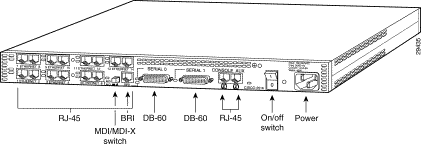
The Cisco 2509, 2510, 2511, and 2512 are designed to function as access servers for remote node and asynchronous/synchronous routing. For complete information, refer to the "Access Servers" chapter in the catalog.
The Cisco 2513, 2514, and 2515 provide higher-density LAN support and support the interfaces listed in the table below.
|
Model |
Ethernet |
Token Ring |
Serial |
|---|---|---|---|
|
Cisco 2513 |
1 |
1 |
2 |
|
Cisco 2514 |
2 |
0 |
2 |
|
Cisco 2515 |
0 |
2 |
2 |
Figure 18-24: Cisco 2513 Rear View

Figure 18-25: Cisco 2514 Rear View

Figure 18-26: Cisco 2515 Rear View

The Cisco 2524 and 2525 provide LAN and WAN access in a low-cost modular router platform that can grow with your internetworking needs. The Cisco 2524 offers an Ethernet (AUI or 10BaseT) LAN connection, and the Cisco 2525 offers a Token Ring (STP or UTP) LAN connection. Both routers can accommodate up to three WAN modules — two synchronous serial and one ISDN.
The choice of synchronous serial WAN modules is as follows:
2-wire, switched, 56-kbps DSU/CSU
4-wire, 56/64-Kbps DSU/CSU
Fractional T1/T1 DSU/CSU
Five-in-one synchronous serial
The choice of ISDN WAN modules is as follows:
ISDN BRI
ISDN with integrated NT1 device
The ISDN WAN modules are keyed so that you cannot insert them into the synchronous serial WAN slots. A blank slot cover is installed over unused slots.
Figure 18-27: Cisco 2524 Rear View
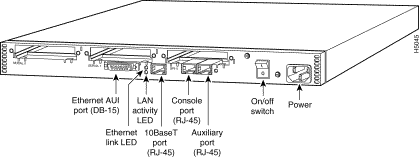
Figure 18-28: Cisco 2525 Rear View
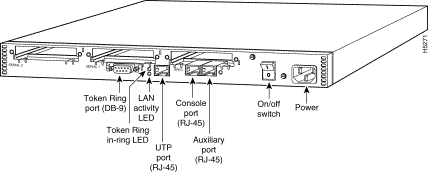
Figure 18-29: 2-Wire, Switched, 56-Kbps DSU/CSU WAN Module
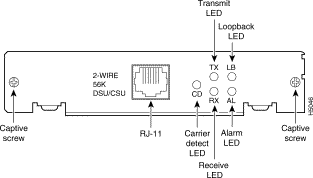
Figure 18-30: 4-Wire, 56/64-kbps DSU/CSU WAN Module
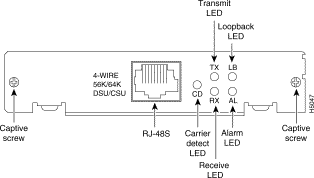
Figure 18-31: Fractional T1/T1 DSU/CSU WAN Module
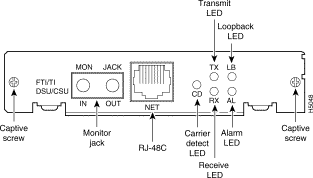
Figure 18-32: ISDN BRI WAN Module

Figure 18-33: ISDN BRI with Integrated NT1 WAN Module

Figure 18-34: Five-in-One Synchronous Serial WAN Module

Figure 18-35: Blank Slot Cover

Software
Refer to the "Cisco IOS Software" chapter for detailed software feature set information.